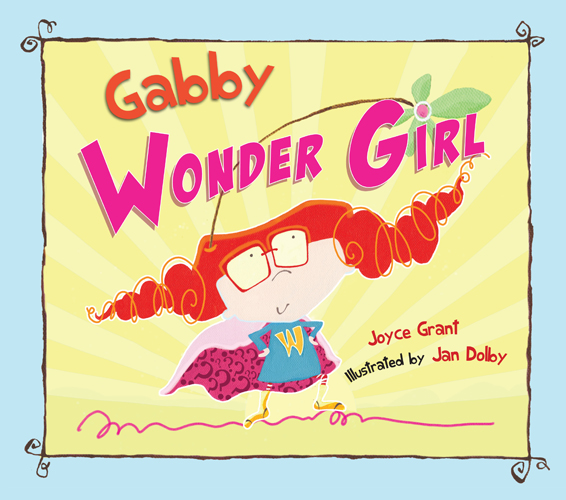| ________________
CM . . .
. Volume XXIII Number 12. . . .November 25, 2016
excerpt:
The story begins with the mystery of an old photo which turns out to be Mrs. Oldham as a young girl. The children discover this when Gabby teaches Roy about the question marks that fall out of her magic letter book. Gabby and Roy use the question marks in order to ask ‘w’ questions that lead them to Mrs. Oldham who happens to be stuck in an apple tree. The quick and fun pace of the book will keep young children entertained as each illustration contains many features to explore. Young readers will become engaged in the characters’ use of colourful flying letters, that come to create words which then become helpful objects in their world. Each illustration also features a cast of critters that are hidden and can b Joyce Grant’s text and Jan Dolby’s illustrations work together seamlessly in order to create a colourful and animated work that is also educational. The final two pages of the work also include activities and online resources related to the book. Some activities include spelling, drawing, enquiry, and exploration which can be enjoyed in a school or home setting. Gabby, Wonder Girl is a worthwhile book that will engage children, educators, and parents with its wonder filled and vibrant pages. Recommended. Vasso Tassiopoulos is a graduate of the Master of Arts program in Children’s Literature at the University of British Columbia.
To comment
on this title or this review, send mail to cm@umanitoba.ca.
Copyright © the Manitoba Library Association. Reproduction for personal
use is permitted only if this copyright notice is maintained. Any
other reproduction is prohibited without permission.
Next Review | Table of Contents For This Issue - November 25, 2016 |

 Gabby, Wonder Girl is the third entertaining and educational book in Joyce Grant and Jan Dolby’s “Gabby” series. This installment of the series follows Gabby and her friend Roy as they become superheroes, named Wonder Girl and Super Roy, in order to help their neighbour Mrs. Oldham. The story stands on its own, but it also offers continuity in terms of letter learning and the development of characters from the previous books. The characters’ discovery of letters, in order to form words, which then turn into objects, is also a theme that continues in Gabby, Wonder Girl.
Gabby, Wonder Girl is the third entertaining and educational book in Joyce Grant and Jan Dolby’s “Gabby” series. This installment of the series follows Gabby and her friend Roy as they become superheroes, named Wonder Girl and Super Roy, in order to help their neighbour Mrs. Oldham. The story stands on its own, but it also offers continuity in terms of letter learning and the development of characters from the previous books. The characters’ discovery of letters, in order to form words, which then turn into objects, is also a theme that continues in Gabby, Wonder Girl. e pointed to by readers. These include a hedgehog, frog, cat, and bird, some of which appeared in previous Gabby books.
e pointed to by readers. These include a hedgehog, frog, cat, and bird, some of which appeared in previous Gabby books.